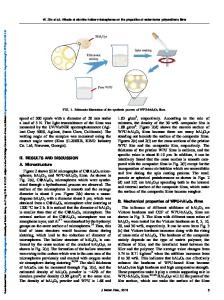Evaluation of the Mechanical Properties of Tribochemical Films on Alumina
- PDF / 2,288,749 Bytes
- 6 Pages / 414.72 x 648 pts Page_size
- 71 Downloads / 334 Views
ABSTRACT This paper presents the results of the mechanical characterisation, by a mechanical properties microprobe or nanoindenter, of tribochemical films produced by the sliding wear of alumina in a humid environment. It was found that the tribochemical films were softer than the remnant alumina on the worn surfaces, and were liable to fracture and cracking under the indenter. INTRODUCTION The wear and friction performance of ceramics have been studied widely over the last decade'. It has been found that extremely low wear rates can sometimes be obtained, but that friction coefficients are normally relatively high confounding initial expectations that friction coefficients should be low because of their high hardness. Two of the most important processes for ceramics are fracture, which is dominant under conditions which produce high wear rates, and tribochemical reactions which often control the rate of wear under low wear conditions. Tribochemical reactions occur between the wearing materials and the surrounding environment, and there is often synergism between this reaction and other wear processes that occur. Major types of tribochemical reaction that can occur are the hydration of oxide ceramics by water vapour in the atmosphere2"4 , and the oxidation of silicon based ceramics such as SiC and Si3N 4 which can also be enhanced by the presence of water vapour5 6' . The reactions are promoted by the high contact pressures and temperatures that are often generated at the wear interface. The main method that can be used for the elucidation of the effect of tribochemical reactions is the microscopical examination of the worn surface. However, this does not provide the fine scale mechanical property that is necessary before a better understanding can be developed of the formation and behaviour of the modified surface layers that are formed in tribochemical wear. This paper describes the preliminary results of a high resolution study of the mechanical properties, by mechanical properties microprobe or nanoindenter (MPM), of the surface layers of alumina specimens that had been subjected to unlubricated sliding wear tests. The results of this study give important information on the mechanical properties of the tribological aluminium hydroxide layers. This information will throw new light on how the layers control the friction and wear that is observed. EXPERIMENTAL Sliding wear tests were conducted on 95 % alumina ceramic as described elsewhere4 under carefully controlled humidity conditions using a pin-on-disc test system. The alumina ceramic had a glassy minor phase which contained SiO 2 and CaO, and Cr20 3 and had a grain size of 15 ptm. The test conditions were an applied load of 40 N, a relative speed of 0.1 m s-', using pins 815
Mat. Res. Soc. Symp. Proc. Vol. 356 01995 Materials Research Society
with a 5 mm rounded end. The test surfaces were given a 0.3 pm Ra finish by diamond grinding. Qualitative information on the variation of mechanical properties across the worn surfaces were obtained using a mechanical
Data Loading...








